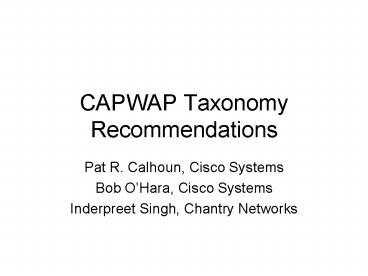CAPWAP Taxonomy Recommendations - PowerPoint PPT Presentation
Title:
CAPWAP Taxonomy Recommendations
Description:
The taxonomy document did a great job of providing a survey of ... We believe the crux of the problem is the terms chosen by the CAPWAP WG, split and local MAC ... – PowerPoint PPT presentation
Number of Views:17
Avg rating:3.0/5.0
Title: CAPWAP Taxonomy Recommendations
1
CAPWAP Taxonomy Recommendations
- Pat R. Calhoun, Cisco Systems
- Bob OHara, Cisco Systems
- Inderpreet Singh, Chantry Networks
2
Problem
- The taxonomy document did a great job of
providing a survey of architectures - It did not provide an unambiguous definition of
Split and Local MAC - As a consequence, all protocols assume different
meaning to the terms - This became obvious in discussions between the
LWAPP and CTP teams - The protocol evaluation team cannot successfully
compare all protocols without a clear set of
definitions - When a protocol claims support for Local MAC,
what does it mean?
3
Architecture Table
Local AP
Split AP
CAPWAP Functions
CAPWAP Functions
AC
802.11 MAC
802.11 Non Real-Time MAC
WTP
AC
802.11 Real-Time MAC
WTP
802.11 PHY
802.11 PHY
4
CAPWAP Functions (overview)
- As listed in taxonomy document
- RF monitoring, such as Radar detection, noise and
interference detection and measurement. - RF configuration, e.g., for retransmission,
channel selection, transmission power adjustment,
etc. - WTP configuration, e.g., for SSID, etc.
- WTP firmware loading, e.g., automatic loading
and upgrading of WTP firmware for network wide
consistency. - Network-wide STA state information database,
including the information needed to support
value-added services, such as mobility, load
balancing etc. - Mutual authentication between network entities,
e.g., for AC and WTP authentication in a
Centralized WLAN Architecture.
5
Contradicting Text
- Following taxonomy text comes to a different
conclusion - The commonalities and differences between Local
MAC and Split MAC are most clearly seen by
comparing Figure 7 and Figure 10. The
commonality between the two is that 802.11
control frames are terminated at WTPs in both
cases. The main difference between Local MAC
and Split MAC is that in the latter the WTP
terminates only the 802.11 control frames, while
in the former the WTP may terminate all 802.11
frames. An interesting consequence of this
difference is that the Integration Service, which
essentially refers to bridging between 802.11 and
802.3 frames, is implemented by the AC in the
Split MAC, but can be part of either the AC or
WTP in the Local MAC.
6
So what is the difference then?
- Split MAC
- Access Point Function (APF) resides in AC
- 802.11 MAC management frames are sent to the AC
- User frames are tunneled
- Local MAC
- APF resides in the WTP
- SME event notifications are sent to the AC
- User frames MAY be tunneled
- Local MAC did not split the MAC due to latency
issues between the STA and the AP for MAC
Management packets
7
Two modes of operation
- We believe the crux of the problem is the terms
chosen by the CAPWAP WG, split and local MAC - The WG should focus on where functionality
resides, instead of how the MAC is divided. - The draft proposes the use of the terms Split and
Local AP
8
Proposed Split vs. Local AP
- Function Location
- Distribution Service WTP
- Integration Service WTP
- Beacon Generation WTP
- Probe Response WTP
- Power Mgmt/Packet Buffering WTP
- Fragmentation/Defrag WTP
- Assoc/Disassoc/Reassoc WTP
- 802.11e
- Classifying WTP
- Scheduling WTP
- Queuing WTP
- 802.11i
- 802.1X/EAP AC
- Key Management AC
- 802.11 Encryption/Decryption WTP
- Function Location
- Distribution Service AC
- Integration Service AC
- Beacon Generation WTP
- Probe Response WTP
- Power Mgmt/Packet Buffering WTP
- Fragmentation/Defrag WTP
- Assoc/Disassoc/Reassoc AC
- 802.11e
- Classifying AC
- Scheduling WTP/AC
- Queuing WTP
- 802.11i
- 802.1X/EAP AC
- Key Management AC
- 802.11 Encryption/Decryption WTP
Given the vast differences between architectures
reviewed, this table uses the most common
functionality split
9
What about Local AP latency issues?
- Introduce Proxy MAC
- Proposal is to allow the WTP to process 802.11
MAC management frames, but forward the frame to
the AC - The end solution is exactly the same, but allows
for a single simpler CAPWAP protocol
10
SME vs. 802.11 MAC management?
Local AP
Split AP
CAPWAP AC Function
CAPWAP AC Function
(Split AP) non real-time MAC mgmt
AC
CAPWAP Protocol
CAPWAP Protocol
CAPWAP Protocol
CAPWAP Protocol
WTP
SME Layer
(Local AP) Non real-time MAC mgmt
802.11 MAC Management
802.11 Real-Time MAC Management
11
Options, capabilities and negotiations
- There is a desire to provide a large number of
modes of operation - We contend that allowing for a complex matrix of
modes of operation will harm interoperability - Proposal
- Limit number of options
- Clearly define the mandatory to implement mode
12
Proposed modes of operation
- Support the following optional features
- User Frame Tunneling mandatory is local bridge
- Local vs. Split mandatory is Local
- 802.11 Encryption mandatory is WTP
13
Conclusion
- The authors of the CAPWAP Taxonomy Recommendation
strongly urge the WG to adopt this document - And of course. Comments are more than welcomed!































